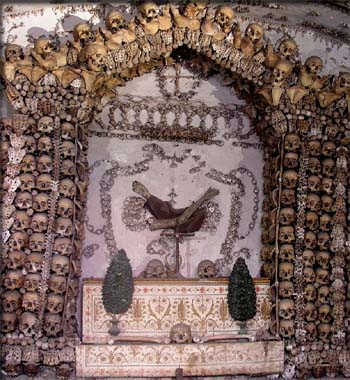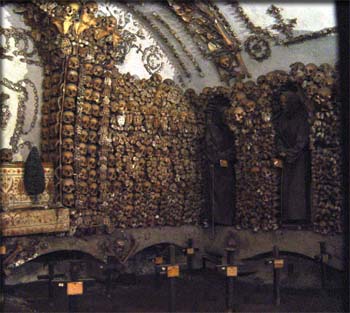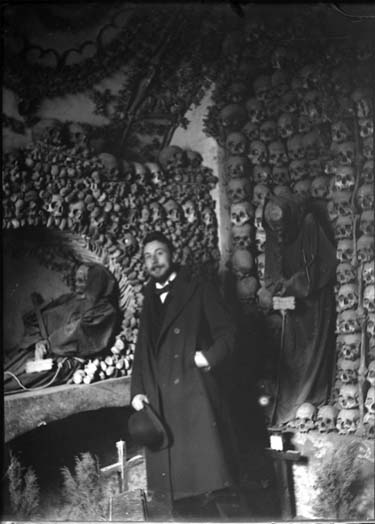pop up description layer
HOME
Cryptozoology UFO Mysteries Aviation Space & Time Dinosaurs Geology Archaeology Exploration 7 Wonders Surprising Science Troubled History Library Laboratory Attic Theater Store Index/Site Map Cyclorama
Search the Site: |
|
Them Bones: A Visit to the Capuchin Crypt
Rome is a city of marvelous history, art and architecture: The Coliseum, the Roman Forum, and Saint Peters Basilica to name a few. However, nothing in the city rivals one site for its macabre display: The Capuchin Crypt, where thousands of human bones have been arranged in a morbid tableau. The church of Santa Maria della Concezione dei Cappuccini sits on the street Via Venetto just steps away from Piazza Barberini and a few hundred feet from the Fontana di Trevi station on Rome's "A" line metro. The exterior of the church seems rather plain, especially when compared to other magnificent buildings of worship in the eternal city. Yet, in the basement of this small chapel lies something unique to the city and to many of its visitors, very disturbing. The Capuchin Order
The church is owned by the Ordo Fratrum Minorum Capuccinorum (Order of Friars Minor Capuchin). This group was established around 1520 by the Franciscan friar, Matteo Bassi. Bassi felt that the Franciscans had drifted away from their original goals of humble piety and wished to re-establish those objectives with the new order. Though he would eventually return to the Franciscans, his new group thrived and was well established by 1630 when the order built the church on Via Venetto with donations from wealthy families in the city. When the monks moved into their new digs, they had a problem: what to do with 300 cartloads of bones of deceased friars. It wasn't uncommon in ancient times to bury a body without a coffin for a few decades after death, then after the body had decomposed, retrieve the bones so the spot in the ground could be reused for the more recently departed. In this case, when the Capuchins moved from their old monastery, they brought the bones of their dead brethren from the last century with them. The bones were placed in the church's basement in five crypts with arch-shaped roofs. By this time the bones were largely unconnected with each other (nobody was quite sure which skull went with which leg or pelvis), so they were organized by type: the Crypt of the Skulls, the Crypt of the Pelvises, the Crypt of the Leg Bones and Thigh Bones, etc. This particular practice of placing bones in a storage chamber under the church was not at all unusual at the time. What was unusual was how they were posed in the crypts. Disturbing Art
Nobody is quite sure how this happened, but many of the bones were arranged artfully around the rooms. In some cases they were turned into chandelers. In other cases, they are arranged in the shape of hour glasses with wings, to remind the visitor of the passage of time. In a few cases the bones have been left together to form skeletons. These figures' empty eye sockets peer out from their hooded monk robes at visitors. Who did this? Nobody knows for sure. However, one legend has it that some monks under persecution in France fled to the Rome facility and hid in the crypts. Bored with their time in the tombs, they started rearranging the bones. In truth, though we don't know exactly when this happened, or for how long it went on. We do know that by 1775 the display was famous enough it was attracting tourists such as the notorious French hedonist, the Marquis de Sade who proclaimed the journey to the crypt was "worth the effort." Another tourist, from the 19th century, was less inpressed. "'This must be a revolting sight', said I to my friend; 'and what appears to me yet more disgusting is that these remains of the dead are only exposed in this manner for the sake of levying a tax on the imbecility of the living,'" wrote the author Jean Baptiste de Chatelain, in his book Rambles through Rome. Visiting the Crypt Today, you can visit the crypt for the modest sum of 8.5 Euros (about $10). The front of the church has a set of steep steps which first takes you into a visitor center where you pay your fare, then walk back through a section of the church that is now a museum chronicling the history of the order and its current works. Finally, a set of stairs takes you down to the crypt level to view the macabre display. Later, as you exit the church's basement area there is, of course, a gift shop that sells postcards and other creepy memorabilia.
The crypt consists of six small rooms with arched ceilings in a row, but only five of them feature the remains of the monks as the sixth acts as a chapel used to celebrate Mass. A sign in one of the crypts tells us "What you are now we used to be; what we are now you will be..." reminding the visitor that what they are seeing is not just art for entertainment's sake, but a warning that all people are mortal and must someday meet their maker and account for what they have done with their lives. While we don't know exactly when and why the display was started, we do have a pretty good idea of when it was completely finished. In the early 19th century the government of Rome outlawed interning bodies within the city limits, so since then the bizarre exhibit has been frozen in time with the mortal remains of about 3,700 monks inside its walls. Today you can visit the crypt and see pretty much the same display that the Marquis de Sade saw in 1755. You just have one rule he didn't have. No photographs. The Capuchin order doesn't take kindly to people who want to take selfies with their dearly departed brothers. |
|
Related Links |
|
|







